Just what are the best fencing shoes?
What are the best shoes for fencing? Do you need to purchase high-end fencing shoes, or can you go with a budget model?
Updated for the 2021-2022 Fencing season.
Fencing shoes are a consistently popular topic of conversation online – you’ll always see new posts, forum topics and reviews cropping up every day. Just what are the best shoes for fencing and what type of shoes should you get, should the top-end fencing shoes be out of your budget range?
First, keep in mind the dynamics of the sport. Fencing requires sudden changes of direction and the fencing lunge exerts a force of up to 7 times the fencers’ body-weight onto their leading heel.
When asked, fencers say they want shoes that are low to the ground and give them a good “feel” for the strip. Fencers also demand lateral stability in their shoes to accommodate the changes of direction.
Many epee and foil fencers also demand good cushioning at the ball of the foot due to the amount of bouncing that they do in setting up for points. (Just watch a few videos of high-level epee fencing for examples.)
In 2008, Nike released their answer to the fencing shoe question – all based on 18 months of research. That research found the following:
- Fencing has among the highest force applied to heel of lead foot in all sports. Up to 7x body weight. Close to the level of impact of a big man (like Shaq) after a dunk!
- The trailing foot takes a lot of damage.
- The lunge impacts the foot at an extreme angle: up to 45 degrees
- Fencers spend a lot of time on their forefoot when in preparation
This means that the shoes need to have:
- Good heel cushioning set at an angle to the heel strike of the lunge
- Flexible uppers and sole to be comfortable when in preparation and “bouncing”
- Durable inner edge to deal with foot drag on the lunge, especially with metal strips
- Traction: wood floors and gyms.
Keep in mind that NACs and larger tournaments are held with fencing strips on top of a concrete floor with minimal padding.
A Quick Summary
The following is a quick summary of the most popular fencing shoes on the market today. Generally speaking, they do the best in their price classes given the conditions above. If you want more detail, continue reading to get a better feel for the full range of options out there!
Top of the Market: Nike Ballestra 2 Fencing Shoes – $185
Up-and-Coming: Kempa Attack Pro – $175
Mid-Market: Hi-Tec Razors from Leon Paul – $100
Budget Fencing Shoe: AF Elite 2017 from Absolute Fencing Gear – $79
Budget Non-Fencing Shoe: Asics Gel Rocket- $40-$80
What type of fencing shoes should I get?
Different fencers have some different (and sometimes conflicting) needs in fencing shoes. Before deciding on a pair, you need to know:
1. Budget
2. Age
3. Level of competition
Age and budget run hand in hand. Young kids are either going to destroy their shoes or outgrow them. You’ll have to look at the number of training hours and how hard they are on their fencing shoes to gauge which model is going to be the best value.
The higher the level of competition, the better shoe you’ll want to buy – mainly for durability on metal strips and for better cushioning and traction at those national events. If you are purchasing fencing shoes for your child, keep in mind that you need to get the pair that are going to last, while also being the best for them and their training schedules. An 11 year old that trains 3 to 5 times per week and is traveling nationally is going to burn through the low end shoes, so they’ll need more than one pair per season.
How long should fencing shoes last?
Most shoes in other sports are targeted to last for a single competition season in that sport. It’s easy for seasonal sports like baseball for kids where you’ll be swapping out cleats each season as your kid’s feet grow.
In fencing, there are overalapping seasons between the youth, junior, and senior ranks and many kids compete across age groups, which muddles the lines between seasons. The top brands are targeting shoes that have the internal cushioning lasting 9 to 12 months.
For youth fencers with a moderate training schedule, the kids will outgrow even the basic shoes before wearing them out. Of course, some clubs have a more intense training schedule which will impact your shoe budget.
Durability on the outsoles of fencing shoes is highly variable depending on the level of activity and the fencing conditions in the fencer’s club.
A fencer who is training 2-3 hours 4 days per week plus local events and NACs will burn through a pair of shoes much faster than the fencer who trains 2 hours for 3 days per week and only goes to one tournament per month.
A fencer who has the more active training schedule should shy away from the “beginner” shoes: the AF Elite and MVPs as those will wear out quickly with a lot of training hours. Opt for something on the higher end for more durability.
Sizing Concerns for Fencing Shoes:
Another thing to keep in mind with fencing shoes is that they are made in men’s sizes only. This creates issues for the women in the sport since you’ll have to do some conversions to get from a women’s foot/shoe size to pick out the appropriate men’s size. This is mainly due to the size of fencing as a sport. We’re hoping that fencing gets large enough to get manufacturers to design shoes specific for women. Until then, it’s up to you to do the appropriate size conversions.
Most fencing shoes run on the narrow side. The various house-brand shoes, PBT, and Adidas all run narrow, so they’re usually one size different. (A woman looking for a women’s US size 7 would order a men’s 6.) The Hi-Tec/Leon Paul and Nike shoes are a little wider, so that conversion is usually 1.5 sizes different (where our women’s 7 would get the men’s 5.5.)
The best thing is to try on the shoes, or order a couple of pair in different sizes and then returning the ones that don’t fit. If possible, its generally a good idea to time buying your first pair of shoes with a tournament large enough for a fencing equipment vendor presence. This way, you can try on a few in person and pick up the pair you like best.
The rundown on some common models of fencing shoes
The list below represents some of the most popular options on the market today, but it is NOT comprehensive. There are shoes on the market that we did not include, for various reasons.
Premium Shoes
Nike Air Fencing Shoe, AKA the Nike Ballestra 2
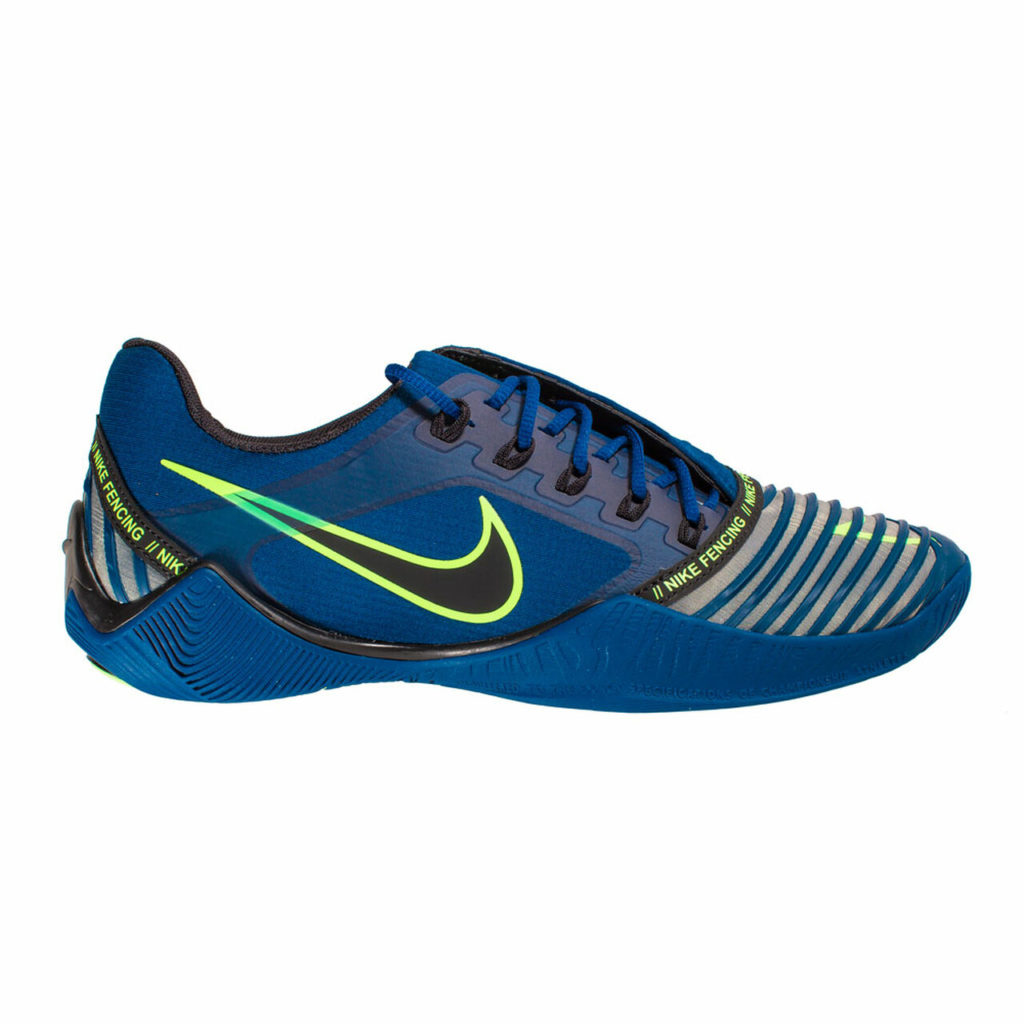
Nike is the official outfitter of the Olympic Games, and every quad they provide shoes for every sport. Some years they refresh their offering, and the 2020 year marks one of those refreshes. Nike’s offerings always have a ton of research and design behind them. The original Ballestras were launched with the 2008 Olympic Games, and you can read a bit about the process Nike went through in our original Nike Ballestra review. The 2020 Ballestra 2 has only built on top of that research, providing a modified and improved product for this Olympic quad.
There are only 4 colorways available for this shoe at the moment – gray/white, gold/white, red/white/blue, blue/green/gray (pictured). If history is any indication, more colorways will become available over time.
The retail version of these shoes is in a white/gray/black model with some colors that were made available to NCAA collegiate teams. The various other colorways are still available from some vendors, though availability is not consistent.
Nike Ballestra 2 – $185 from APS
Nike Ballestra 2 – $189 from Absolute Fencing Gear
The 2008-2020 Nike Ballestra
This was the gold standard for fencing shoes for a long time, but was replaced in 2020 by the Ballestra 2 (above). These shoes were briefly renamed to the Nike Air Zoom fencing shoes, but reverted to the Ballestra.
These are still available at various retailers at various prices, but are generally speaking not being restocked, so availability is becoming more limited. Many people still prefer the design and performance of this shoe, and right now in mid 2021, availability for this shoe is still fairly high while prices are dropping, so this could be a good buy if you can find your size.
The retail version of these shoes is in a white/gray/black model with some colors that were made available to NCAA collegiate teams. The various other colorways are still available from some vendors, though availability is not consistent.
Nike Ballestra – $150-180 from APS
Nike Ballestra – $125-180 from Absolute Fencing Gear
Kempa Attack Pro
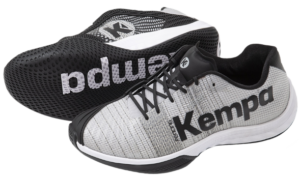
This is the up-and-coming popular shoe. It is new on the market as of 2019, but seeing a lot of adoption with more elite fencers. This shoe is a collaboration between Kempa, a well-known European handball shoe company, and Allstar/Uhlmann. It’s become a very popular alternative to the Nike Ballestra.
It’s handball origins result in it having a fit closer to court shoes – a little wider base and slightly smaller fit than the Nike and Adidas models. Their longevity is still unknown given their freshly released status, but people are currently reporting short term positive results. The Kempa Attack Pros seem to be able to withstand their fair share of wear and tear.
Kempa Attack Pro – $175 from Fencing Post
Kempa Attack Pro – $175 from Blue Gauntlet
Mid-Range Fencing Shoes
Hi-Tec Razor Shoes
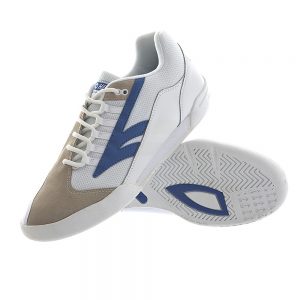
The Razor is the latest model of fencing shoe from the Leon Paul/Hi-Tec joint venture and are only available for purchase from Leon Paul. They straddle the line between high end and budget fencing shoes, with a number of high end features with a $100 price tag. Notably, they are made primarily of moisture wicking material, have offset lacing to protect the laces from abrasion, and an extra heel cup for heel protection.
Hi-Tec Razors from Leon Paul – $100
Budget Fencing Shoes:
These are the entry-level cheap fencing shoes. These are all under $100 and trying to get as close to the $50 price point as they can.
AF Elite 2017

The AF Elite 2017 is the third generation of the Elite line of fencing shoes from Absolute Fencing Gear. The NJ manufacturer offers this shoe all the way down to a size 3 to get into the kid’s market. The shoes run on the narrow / small side, so those with wide feet may need to order a half size up. These are basic, value shoes that will certainly last longer on a strip than a non-fencing or street shoe. Those who are hard on shoes or train an intense schedule will likely eat these up faster than once per season.
AF Elite 2017 from Absolute Fencing Gear – $79
Kempa Attack Junior
These are a much more affordable version of the Kempa Attack Pro, but are only available in children’s sizes. Features include a Velcro fastener and semi-elastic laces. A great option for kids who need a more durable, serious shoe, but will probably outgrow their shoes fairly quickly.
Kempa Attack Junior – $80 from Fencing Post
What are the best non-fencing shoes for fencing?
It’s tough when you have to shell out $120 – $175 every 9-12 months for new shoes. It’s worse when you’re one of those fencers who are notoriously hard on shoes. For that reason, many fencers have turned to their local sporting goods store to find a decent non-fencing shoe that meets the demands of fencing while still providing a good value.
There are some types of shoes to look for and some to make sure to avoid.
The most popular shoes to use have been court shoes. These are shoes made for sports like raquetball, squash, and even volleyball. Those sports feature lots of lateral motion and lunging actions. This means that they will be low to the ground and have cushioning set up for the heel strike (for your front foot) as well as the lateral stability for side to side motion (for your back foot).
Kempa Attack Shoes
These are the non-fencing version of the Kempa Attack Pros. Kempa has a wide range of other court shoes, and they are all constructed of similar quality, just without the fencing-specific finishing touches that the Attack Pros have.
Various Kempa Attack Shoes at Amazon.com – $50-$120
Asics Gel Rocket
The Asics make a decent shoe if you’re on a budget. The Asics have been reported to work out fine as a fencing shoe, but their durability is suspect on rough metal strips. Older models have actually had the gel come out of the sole after extremely intense use on metal strips! They’re reported to be a bit heavier than other shoes in their class. Epee fencers in particular tend to prefer these shoes more than the other weapons.
Asics Gel Rocket from Amazon.com – $40-$80
Adidas Stabil series
The Stabil has received the rave reviews from fencers on the forums, but the entire series has been pretty well received. These are a staple in the epee fencing community. The wide foot base and thin sole (relative to other court shoes) allow for a good “feeling” of the strip and fast direction changes. A typical review quote (for the Stabil Vs):
“These shoes, in one word, rock. I will never again use a traditional fencing shoe. Good cushion, etc, and they’ve suffered 1 year of heavy usage on “cheesegrater” aluminum strips without complaint. I replace the insoles about every 6 months, but other than that, no upkeep. I love these things”
The Stabil line has a number of models, many of which are simultaneously in production and widely available from many sports retailers and shoe stores.
Adidas Stabil X at Amazon.com – ~$99
Adidas Stabil Bounce at Amazon.com – ~$110
Shoes to Avoid:
Any “fencing” shoe made by a major fashion designer.
There are “fencing” shoes out there by some major designers. When you take a look at them, they resemble fencing shoes and that’s because they are fashion (read: walking about town) shoes that were inspired by the sport of fencing.
There is absolutely nothing in the shoe designed to hold up to athletic performance or usage. Wear them out on the town, but take them off in the fencing club.
Wrestling shoes.
Some misguided souls take a look at wrestling shoes and say “hey, that’s *really* low to the ground, I’ll really feel the strip in those” and they get them. A couple of weeks later they’re complaining about foot, knee, and lower back pain.
Wrestling shoes are made to be used when competing on a 2 inch thick mat. Nothing about that says “durability on a strip” or “heel cushioning for a lunge.” Avoid wrestling shoes at all cost. If you see someone at your fencing club suited up to fence and wearing wrestling shoes, put them in a 3/4 nelson, pin them to the floor, and make them go put on something suitable.
Other things to get:
Once you have your fencing shoes, you may need to go ahead and get a few upgrades. Things that we’ve found useful over the years:
Hard heel cup. The hard heel cup is a hard plastic heel insert. Use these for your front foot. What the hard heel cup does is keeps your heel from flattening out during the lunge, allowing your heel’s fat pad to do more work in cushioning the blow of the lunge. The Nike shoes have a hard heel cup integrated into the design, but if you have a tendency to get a bruised heel, go ahead and get one. They’re about $5.00 from most fencing equipment retailers.
Avoid the soft gel heel cups. They raise the height of your heel in the shoe, plus the grip on your sock, which means you’re a lot more likely to put holes in your socks while fencing.
Cushion insoles. On lower end shoes like the AF and Blue Gauntlet house brands, spending another $15 to $20 on cushion insole will make you feel a lot better towards the end of the day during your fencing tournaments. Check out the SoftSol inserts and get the one that has a good heel strike and protection for the ball of the foot. They make several models matching up with different foot-impact styles.


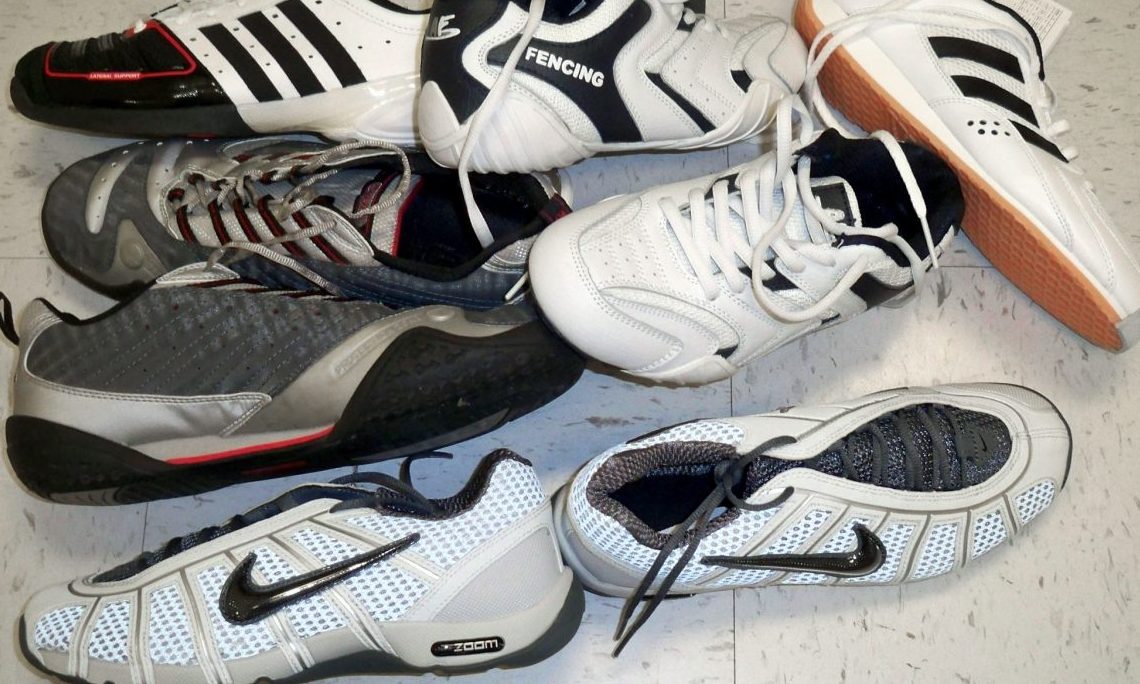





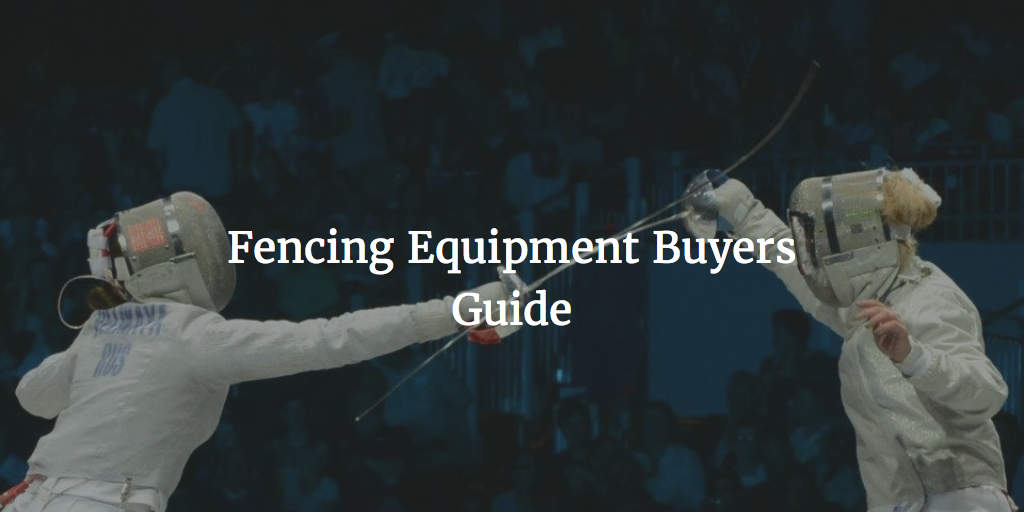

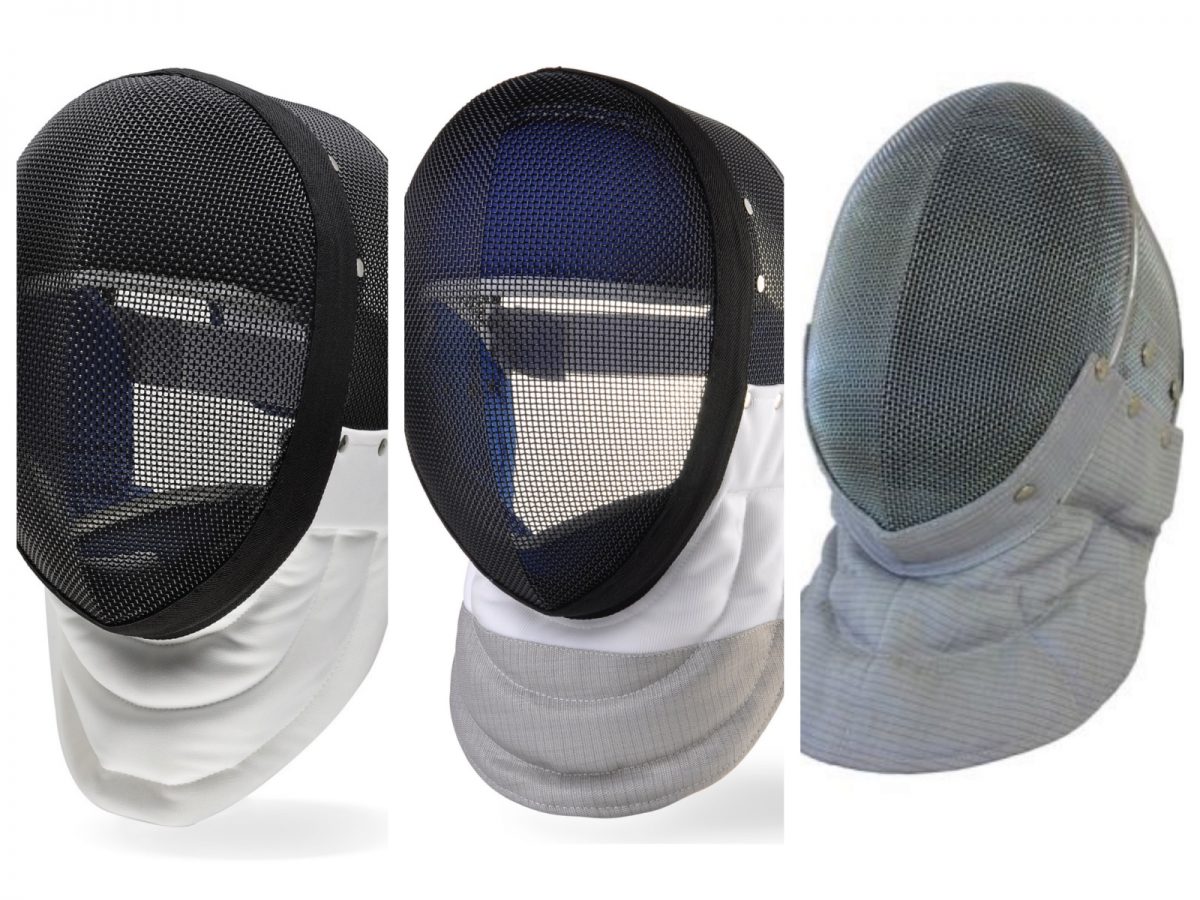
14 Comments
Comments are closed.